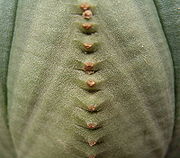
Euphorbia obesa
Encyclopedia
Euphorbia obesa is a subtropical succulent
species
of Euphorbia genus
. It comes from South Africa
, especially in the Cape Province
.

 The plant is dioecious
The plant is dioecious
which means that a subject has only male or female flowers.
In the wild, it is endangered because over-collection and poaching, because of its slow growth, and the fact that the pod contains only 2 to 3 seeds. However, it is widely cultivated in botanical gardens.
Its diameter is 6 cm for young subjects, but can reach 15 cm for the old ones.
Its shape is spherical for young individuals and cylindrical for the old ones. It contains a water reservoir for periods of drought.
 It almost always shows 8 ribs adorned with small deep gibbosity regularly planted on the edges.
It almost always shows 8 ribs adorned with small deep gibbosity regularly planted on the edges.
It is green with horizontal lighter or darker stripes. In the wild, and with exposure to direct sunlight, it shows red and purple areas.
The small flowers are insignificant in apex. In fact, like all Euphorbia, flowers are called cyathia
.
Like all Euphorbia, the latex sap is toxic.
Living in similar conditions on two different continents, Euphorbia obesa presents a form convergence
with Astrophytum asterias
which is a cactus from Mexico.
Succulent plant
Succulent plants, also known as succulents or fat plants, are water-retaining plants adapted to arid climates or soil conditions. Succulent plants store water in their leaves, stems, and also in roots...
species
Species
In biology, a species is one of the basic units of biological classification and a taxonomic rank. A species is often defined as a group of organisms capable of interbreeding and producing fertile offspring. While in many cases this definition is adequate, more precise or differing measures are...
of Euphorbia genus
Genus
In biology, a genus is a low-level taxonomic rank used in the biological classification of living and fossil organisms, which is an example of definition by genus and differentia...
. It comes from South Africa
South Africa
The Republic of South Africa is a country in southern Africa. Located at the southern tip of Africa, it is divided into nine provinces, with of coastline on the Atlantic and Indian oceans...
, especially in the Cape Province
Cape Province
The Province of the Cape of Good Hope was a province in the Union of South Africa and subsequently the Republic of South Africa...
.


Dioecious
Dioecy is the property of a group of biological organisms that have males and females, but not members that have organs of both sexes at the same time. I.e., those whose individual members can usually produce only one type of gamete; each individual organism is thus distinctly female or male...
which means that a subject has only male or female flowers.
In the wild, it is endangered because over-collection and poaching, because of its slow growth, and the fact that the pod contains only 2 to 3 seeds. However, it is widely cultivated in botanical gardens.
Description
Euphorbia obesa looks like a perfect ball, thornless and extremely decorative.Its diameter is 6 cm for young subjects, but can reach 15 cm for the old ones.
Its shape is spherical for young individuals and cylindrical for the old ones. It contains a water reservoir for periods of drought.

It is green with horizontal lighter or darker stripes. In the wild, and with exposure to direct sunlight, it shows red and purple areas.
The small flowers are insignificant in apex. In fact, like all Euphorbia, flowers are called cyathia
Cyathium
A cyathium is one of the specialised pseudanthia forming the inflorescence of plants in the genus Euphorbia . A cyathium consists of:...
.
Like all Euphorbia, the latex sap is toxic.
Living in similar conditions on two different continents, Euphorbia obesa presents a form convergence
Convergent evolution
Convergent evolution describes the acquisition of the same biological trait in unrelated lineages.The wing is a classic example of convergent evolution in action. Although their last common ancestor did not have wings, both birds and bats do, and are capable of powered flight. The wings are...
with Astrophytum asterias
Astrophytum asterias
Astrophytum asterias is a species of cactus in the genus Astrophytum, and is native to small parts of Texas in the United States and Mexico. Common names include Sand Dollar Cactus, Sea Urchin Cactus, Star Cactus and Star Peyote....
which is a cactus from Mexico.

